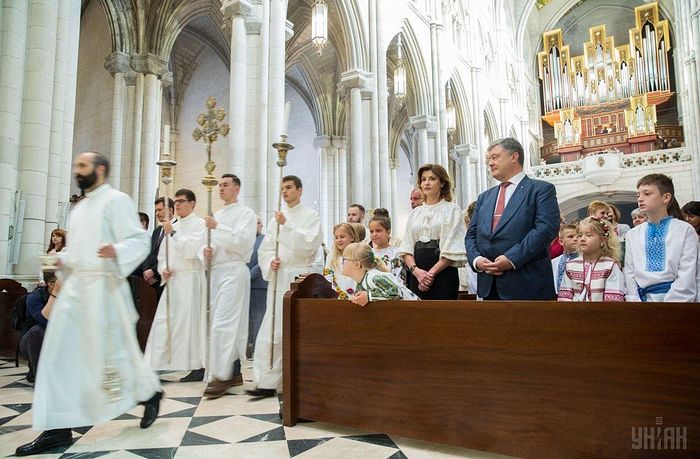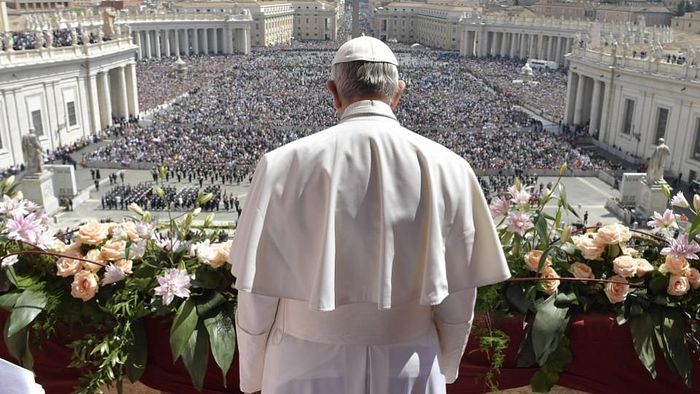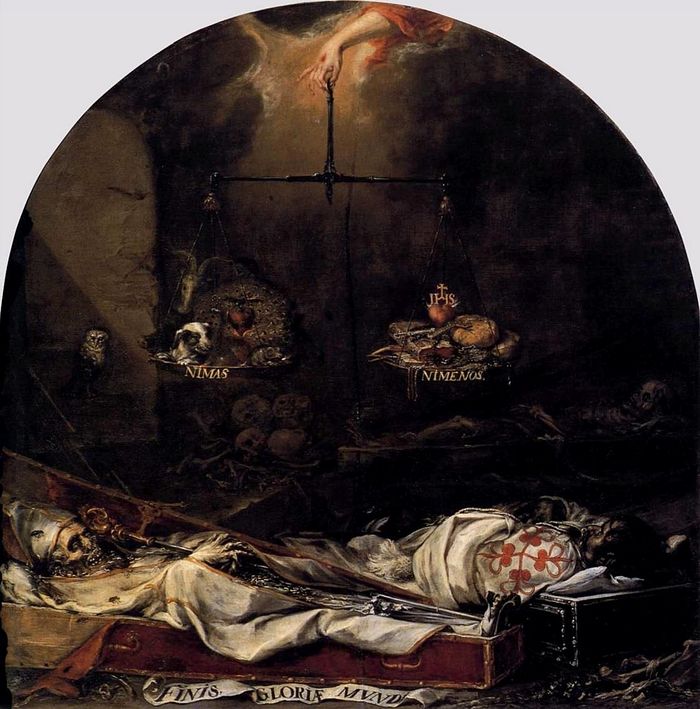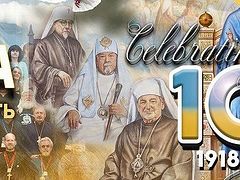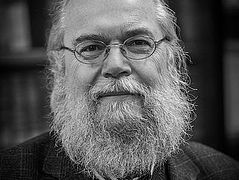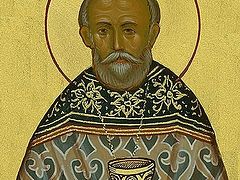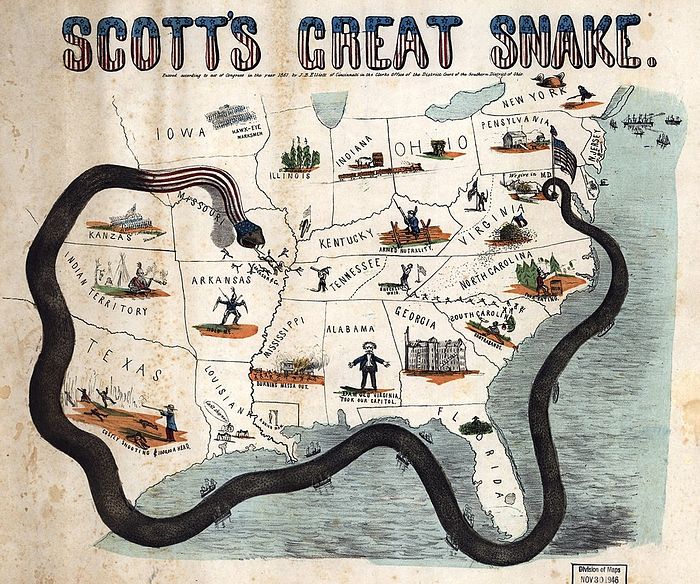 1861 map of General Scott’s Anaconda Plan. Photo: wikipedia.org
1861 map of General Scott’s Anaconda Plan. Photo: wikipedia.org
The “Anaconda Plan” was first formulated during the American Civil War by General Winfield Scott of the Union Army. The plan basically consisted in squeezing a circle like an anaconda, blocking the enemy territory from the sea and land, and cutting off access to ports, which was to lead to the enemy’s strategic exhaustion.
The launching of the project, “Orthodox Church of Ukraine”, testifies to yet another serious movement in the Vatican’s age-old, ongoing strategy to swallow up the Orthodox world. And one of the Papal throne’s main instruments for carrying out its objectives is and will continue to be the Ukrainian Greek Catholic Church.
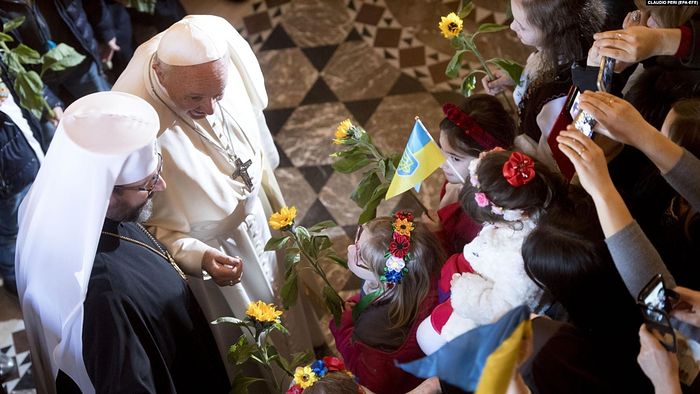 Pope Francis in the Greek Catholic Ukrainian cathedral in Rome.
Pope Francis in the Greek Catholic Ukrainian cathedral in Rome.
On April 28, 2019, Archbishop Claudio Gugerotti addressed those in attendance at the Uniate patriarchal cathedral in Kiev, saying that Pope Francis has prepared a surprise for the UGCC.
In the nuncio’s words, the head of the Vatican wishes to demonstrate an even greater closeness and more serious support for the Ukrainian Uniates. “The Pope has a specific sign in his heart. I am telling you this specially in order to arouse your interest. For now I am unable to say more. I think that soon what the Pope wants to do will be published. Primarily this is regarding support,” emphasized the apostolic nuncio.
In literally just a few days, on May 4, the information department of the UGCC published a communiqué about how Pope Francis has invited Archbishop Sviatoslav (Shevchuk), the members of the synod, and the metropolitans of the Ukrainian Greek Catholic Church to visit Rome on July 5–6, 2019.
If we take apart the essence of this extremely convoluted text it becomes clear that in the Italian capital they are planning to have an intensive brainstorm with a deep analysis of the situation in Ukraine, and to discuss the key problems and prospects taking shape for the Roman Catholic Church and the Ukrainian Greek Catholic Church after the recent presidential elections. The results of this work is supposed to be a strategy with a studied program of action aimed at increasing the effectiveness of both religious organizations’ activities (especially of the UGCC) on the territory of the Ukraine.
Shevchuk himself talks about the upcoming event in the most enthusiastic terms, because such a thing takes place very, very rarely. As the Uniate leader confirms, the pontiff’s decision is good news for the UGCC, because a meeting format like this is of the highest level of attention from the Vatican.
As for the above mentioned “promising strategy”, as Shevchuk noted it will rest upon three important supports. The first is personal participation of the Pope of Rome in the process of supporting the UGCC (the accent will be placed on improving personal understanding and the pontiff’s directly receiving information on the life and needs of this structure). The second is a significant increase in the Uniates’ apparatus and ideological weight in the system of creating Vatican politics in the “Ukrainian sphere” (it can be supposed that the UGCC will directly participate in the development of the papal throne’s vision and strategy with regard to Ukraine, and will also more actively cooperate with the functionary structures of the Roman curia in matters of forming practical mechanisms for putting such strategies into practice). The third is the Vatican’s guarantee of the UGCC’s proper growth according to the “challenges that have appeared before the Ukrainian church in Ukraine and abroad.”
In the opinion of a number of experts, including the religion scholar Alexei Smirnov and polemicist Alexander Vosnesensky, such signals from Italy can, among other things, be demonstrating the Papal throne’s readiness to grant the UGCC a patriarchate1 in the foreseeable future.
The anaconda ring: Government
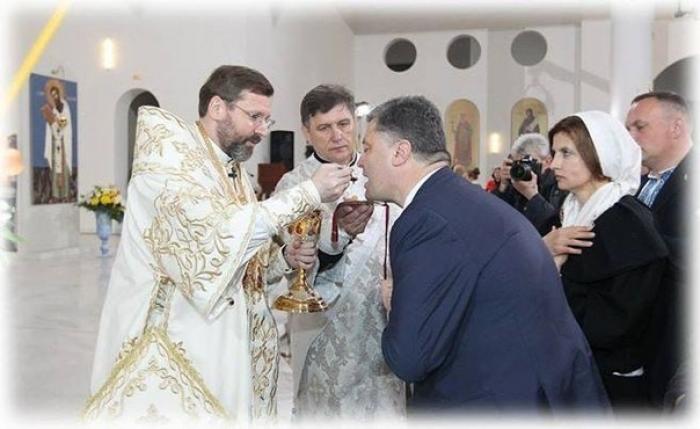 Ex-President Poroshenko taking Communion from Greek Catholics.
Ex-President Poroshenko taking Communion from Greek Catholics.
A key factor that provides for the fulfillment of objectives necessary for this course of action is the massive presence of people representing the pro-Catholic lobby in key positions in the Ukrainian government.
It must be admitted that up until recent times, such a level of penetration to the very peak of the “political Olympus” would have been exorbitant.
First of all, the Ukrainian ex-president demonstrates great fealty to the UGCC. At certain moments the head-on question even arose—has Petro Poroshenko converted to the Uniate faith? After all, the head of the government publicly receiving Communion in the UGCC cathedral in Kiev, along with his frequent participation in joint Greek Catholic prayer events, spoke volumes.
In fact Poroshenko himself recently put the dot on the “i” on this question. On April 29, 2019 he gave a speech in Lvov2 in the UGCC Church of God’s Wisdom, and allowed himself to essentially stake out a leading role for the Uniates in the religious life of Ukraine (in the president’s words, it is precisely the UGCC that “exactly rules over the Christian faith in the Ukrainian nation”).
Secondly, at the present moment, part of the unspoken zone of Uniate influence is the post of Speaker of Parliament, occupied by a parishioner of the UGCC Andrei Paruby. Due to a great extent to his hyperactivity and stubbornness, such odious initiatives have passed through the Supreme Rada as that body’s appeal to Patriarch Bartholomew to grant autocephaly, as well as the law by which the Ministry of Culture is now trying to deprive the Ukrainian Orthodox Church of its official name.
It is also worth adding that another deputy who is loyal to the UGCC has entrenched himself in the position of deputy chief of the Committee on matters of culture and spirituality of the Ukrainian Supreme Rada. We are talking about Victor Elensky, who is one of the main ideologues in the administrative attack on the Ukrainian Orthodox Church. And as a number of experts consider, he also is responsible for the “American” financial channel that feeds Ukrainian Uniates.
Thirdly, the key position—from the point of view of direct governmental influence over religious processes in the country—of Minister of Culture is also within the range of UGCC influence (Evgeny Nishchuk has long been open about the fact that he is a Greek Catholic).
Other governmental agencies are also heavily weighted with people loyal to Uniate powers—the presidential administration, the Cabinet of Ministers, security and anti-corruption agencies (for example, the head of the Specialized Anti-Corruption Prosecutor’s office Nazar Kholodnitsky), the Prosecutor General (according to the information of polemicist Alexander Voznesensky, its head, Yuri Lutsenko has identified himself as parishioner of the UGCC since 2016).
Against the background of this overwhelming representation of the Uniate party in the system of governmental authority, the Roman Catholics, as it would seem at first glance, can’t boast of much success. However this is not an entirely correct assessment of the situation. The Vatican simply prefers to remain in the shadows, pushing the UGCC to the forefront as a kind of battering ram that is supposed to provide the disposition the papal throne needs, and which is supposed to take upon itself all the negative press connected with this process.
Furthermore the Roman Catholics are quite amenable to the practice of their emissaries’ point work with the more important figures of the governmental Olympus, to whom for one or another reason the Uniates cannot get as close. In part, we recall the activities of Yuri Tandit, whose role as councilor to Minister of Internal Affairs Arsen Avakov allows the pro-Catholic forces to have constant operative access to a very powerful official, who was recently one of Poroshenko’s main rivals in the struggle for power in the country.
On the whole, such an arrangement of powers has presented the Vatican-UGCC tandem not only with essential opportunities for intensive and all-encompassing promotion of their long term interests in the religious sphere of Ukraine, but also allowed them to turn on a powerful administrative machine to “clear out” the Ukrainian Orthodox Church—for it is the main roadblock to Catholicizing the Ukrainian people. Moreover, such a large scale infiltration by the pro-Catholic camp’s adepts and agents into government power structures has created for it a unique situation in which it can camouflage the promotion of its own church’s initiatives as being state interests in the spheres of humanitarian action and national security.
The anaconda plan: Occupation
One has to hand it to the Uniates for their zeal and commitment—within the framework of a political reality that was favorable for them3 they significantly broadened their presence in the Ukrainian lands.
One of the clearest confirmations of this theory are Shevchuk’s own words, spoken on August 9, 2018 during his visit to Stamford (U.S.A.)
“The Ukrainian Greek-Catholic church is now experiencing strong growth. Such rapid growth in our church as we have had over the past five years is something we have not seen since the moment that the UGCC came out from underground in the early 1990s. Now there isn’t a single large city in Ukraine where a UGCC temple has not been built,” stressed the head of the UGCC.
It must be admitted that this assertion was not empty boasting. Over the years since their victory in the Maidan (coupe), the Uniates have managed to infiltrate deeply into the territory of the Ukrainian Orthodox Church. Thus, even in Zaporozhe (the regional center of the cradle of Cossackry, which historically activity fought against the spread of the Unia in Ukraine), three UGCC churches have been built. And they were lavishly built, in prestigious and upscale regions of the city.
In this context it is quite telling that this expansion by the UGCC is happening with the active and even public support of the Vatican. It is enough to recall the visit to the Ukraine by the prefect of the Congregation for Eastern Churches, Cardinal Leonardo Sandri, who in the summer of 2017 gave money on behalf of the Pope of Rome for the construction of a monumental Uniate church in Kharkov and for the development of a Kharkov exarchate of the UGCC.
Incidentally, the Catholics themselves are not far behind their Uniate “little brothers”. Just a few days ago I was told a story about the energetic activities of one Roman Catholic priest in a region not far from the Sviatagorsk Lavra.4 When asked whether it made any sense for him to conduct such a storm of activity (in a place where there are no members of the Roman Catholic Church), he answered that it was no problem that there are no parishioners; the main thing is that there is money to conduct that work with the population. By the way, we are talking about several million euros. What is interesting is that part of that money is earmarked for the publication of monographs and books that are supposed to somehow base from a historical perspective the legitimacy of a catholic presence in the region of the Donbass.5 As it is said, he who has ears to hear, let him hear!
The Anaconda ring: Clean up
The expansion of the Uniate/Catholic zone of influence is bound up with increased pressure on the Ukrainian Orthodox Church—the largest confession in Ukraine, with functioning parishes in all the regions of the country. In the words of experts, the pro-Catholic forces are carrying out their attack on their main opponent on both the strategic and local levels.
On the first level, the mechanisms and possibilities of the highest governmental institutions are at work. Primarily we are talking about the Ukrainian parliament.
Notably, one of the most important agencies acting to this aim is the interfractional delegation, “Nastuplenie”, which includes the people’s elect—representatives of the social movement, “Svobodnie Liudi” (Free People; one of it coordinators is the deputy Andrei Levus—a Uniate and longtime cohort of Parliament Speaker Andrei Paruby). This alliance was the initiator and formulator of the Ukrainian Supreme Rada’s appeal to Patriarch Bartholomew to grant ecclesiastical autocephaly. And the deputies of this alliance authored the scandalous legislative projects aimed at totally crushing the Ukrainian Orthodox Church (5309, which is intended to result in the Ukrainian Orthodox Church changing its official name, and in the de facto creation of conditions for wide scale raider seizure of its property; and 4511, which substantially limits the rights of the UOC in matters of its self rule and functioning).
On the second layer are representatives of the organs of local government and Uniate (less often, Catholic) activists, who organize or participate in the seizure of churches from the canonical Orthodox Church in favor of the “OCU”.
The anaconda ring: Absorption
The active and wide scale participation of pro-Catholic forces in the global attack on the UOC can be explained by their desire to crush canonical Orthodoxy in Ukraine, combining its shattered pieces into the socio-political project called the “OCU” (another fact that testifies to the accuracy of this assessment was this structure’s universal participation in agitation and other forms of election campaigning for one of the candidates of the recent presidential elections in Ukraine).6
The logic of this approach is simple—by destroying the UOC and accentuating the “OCU” as the new and largest “Orthodox confession” in the country, in answer to the geopolitical, political, and ideological demands of the day (basically turning it finally from a religious structure into an instrument of political influence), the pro-Catholic camp will gain an opportunity to fundamentally cut off the connection of millions of Ukrainians who identify themselves an Orthodox from the many centuries-long history of the Orthodox faith throughout the expanses of Little Rus’.7
And this would be the victory of victories [for the pro-Catholic forces]. After all, without knowing the origins of true Orthodoxy, viewing their faith as an element primarily of “Ukrainianism”, held captive by nationalist and ideological mirages, and also being basically an appendage of the state authorities, the “bishops” and “clergy” of the “OCU” will sooner or later agree with the proposal to unite with Uniates and accept the Pope of Rome as their head. They won’t even have to conjure up anything in particular to accomplish this. The authorities will, for example, only have to announce the combining of the “OCU” with the UGCC as necessary for receiving membership in the E.U. The Pope of Rome on behalf of his new flock will be ready to come out as the main lobbyist for Ukrainian Euro-integration and the processes will be set in motion, supported, and completed in the shortest possible time.
Of course, this is so far a matter for the distant future. Nevertheless, the Uniates (and the Roman Catholics) are already actively working hard to prepare everything in the best possible way for that moment.
In part, activities are being focused on blurring the boundaries between the Greek Catholic and Orthodox faiths, as well as erasing from everyone’s memory all the negative events connected with inculcating the Unia in the Ukrainian lands. The main auditorium for this are those “clergy” of the “Orthodox Church of Ukraine/Ukrainian Orthodox Church Kiev Patriarchate” who, for a number of objective and subjective reasons, are the idea subjects for such manipulations.
As one of the clearest examples of this active political strategy are the joint “services” by representatives of the RCC, the UGCC, and the “UOC KP”, headed by Bishop Vitaly Skomarovsky of the Lutsk diocese of the RCC, the Lutsk exarch Josaphat Goveroi, the ruling bishop of Sokalsko-Zhovkovsky diocese of the UGCC Mikhail Koltun, and the “Bishop of Vladimir-Volyn, “UOC KP” Mattfey Shevchuk, which took place on November 2, 2018 in the Uniate church of Sts. Joachim and Anna (Vladimir-Volyn). This event was dedicated to the veneration of Josaphat (Kunstevich), who has gone done in Orthodox history as its furious persecutor and foe. It is very telling that this fact did not at all disturb the high-ranking member of the “UOC KP”, who participated in joint prayer before the “reliquary of St. Josaphat” and expressed the necessity for unification with the UGCC “not in words but in deed”.
A no less significant trend in the widening of the “Overton window” in the Uniates’ interests is the operation being devised for the UGCC to basically swallow and “digest” one of the parts that broke off from the “Ukrainian Autocephalous Orthodox Church”—the “UAOC (o)” (earlier called the Kharkov-Poltava diocese of the “UAOC”). This process was sanctioned and approved by the Vatican, which de facto created the first historical precedent in modern Ukraine of the transfer into the Unia of a religious structure that positioned itself as Orthodox. In the opinion of experts, this initiative should be considered a peculiar form of final trial run technology for integrating Ukrainian Orthodoxy into Catholic structures. In connection with this, by the way, it is worth paying attention to the fact that the process of combining the “UAOC (o) into the UGCC was not stopped even after the creation of the “OCU” as the collection point for the various organizations that left Orthodoxy for schism. This demonstrates yet again that the Uniates do not view the structure formulated by the Phanar as a long-term, independent, and equal player in the Ukrainian religious sphere. Moreover they are preparing for the “OCU” a certain other, much less significant, and much more thankless role.
We can judge about its characteristics and boundaries from an interview with Shevchuk in the publication, “Obozrevatel” (Observer), dated March 18, 2019.
First of all, the head of the Ukrainian Uniates noted that he agreed with the head of the “OCU”, Epiphany, to conduct regular meetings, during which they will discuss the prospects and parameters for both structures to come closer together. Secondly, this process will take place within the framework of both parties’ agreed-to road maps (at this Shevchuk emphasized that the UGCC already has such a road map, which will be modified according to the views of the “OCU”; de facto this means that the Uniates are making their own concept the basis for this merger). Thirdly, from an interview with Shevchuk it is becoming clear that the UGCC will be orienting itself toward a soft and careful absorption of the “OCU”. In connection with this they are planning for now to abstain from forming a common structure, instead putting the main emphasis on restoring “Eucharistic communion” with the organization headed by Epiphany and “the possibility of serving Divine Liturgy at the same altar.” Fourthly, the head of the Uniates made it quite clear who he sees as the “elder” and who the “younger” partner in the future tandem. In his words, the UGCC, as opposed to the “OCU”, is not a “local church”, with parishes exclusively in Ukraine. And this gives the Uniates the right not only to obtain the status of a patriarchate, but also in the capacity of a “global church” having a de facto ready-built structure of patriarchal government”, to lock the entire Ukrainian diaspora into itself for spiritual overseeing. Fifthly, conspicuous is Shevchuk’s demonstrative avoidance of the question about whether the unification of the UGCC with the “OCU” will be the unification of “equals”.
On May 11, 2019, speaking in Philidelphia before members of the diaspora, the head of the Ukrainian Uniates turned up the volume on similar signals. He pointed directly to the fact that at the current stage, the most complicated task set before the UGCC is to build its own patriarchate, which, among other things, should become the instrument for gathering all those “in dispersion”. Who he means by this category can be judged from Shevchuk’s following statement: “We have to build a patriarchate and extend our hand to our Orthodox brothers for unity.”
And what is interesting—that hand is really ready to shake his. Thus, in an interview with the TV channel “Espresso”, Epiphany announced that he does not exclude the possibility of uniting the UGCC with the “OCU”. “At a meeting with His Beatitude Sviatoslav, we talked about a further deepening of our cooperation. In this cooperation we will come to dialogue, and then that dialogue will determine whether we can unite. Theoretically this is possible in the future. But is depends upon how we work together, support this friendly relationship, and work toward this unity”, the head of the “OCU” noted in part.
The Anaconda ring: A Front
The effectiveness and temporary parameters of the Catholicization process in Ukraine depends greatly on the possibility to shield it from internal and external influences. In the first dimension it provides a course to destroy the UOC, and in the second dimension it pulls the Russian Orthodox Church into a certain system of coordinates of “global cooperation and mutual action” with the Vatican, which substantially ties the hands of the Moscow Patriarchate in any meaningful and quality reaction to the negative tendencies acting against it in the Ukrainian religious sphere.
We have to consider as a clear example of this approach the signing of the Havana declaration, in which points where fixed against any form of proselytization by the Vatican and the ROC amongst each others’ members, as well as the neutralization of the “Uniatism” method as the supposedly right path toward a “restoration of unity”.
In practice it can be seen that all of this was only lip service. The Papal See was simply buying time while it penetrates Eastern Ukraine unhindered and strengthens the pro-Catholic forces there, and prepares to conduct a massive attack against the UOC’s position.
Meanwhile, the Vatican has not once come out in defense of a supposedly strategic partnership with the ROC on key situations for Orthodox Moscow. Thus, it has distanced itself from any real attempts to bring the UGCC to reason or punish it for its raider seizure of an Orthodox church in the town of Kolomya, or the public statements by members of the UGCC clergy about their readiness to snatch all the churches of the UOC in favor of the UGCC. Also quite telling was the presence at Epiphany’s inauguration of high-ranking representatives of the Roman Catholic Church—the heads of the conference of Roman Catholic bishops Bronislav (Bernatsky) and metropolitan of Lvov RCC in Ukraine Mechislav (Mokshitsky).
Now the Vatican wants to repeat a successfully performed trick. To this aim, it is intensively, behind-the-scenes “feeling out” the ROC’s readiness to receive the Pope of Rome in Russia.
This approach, as well as possibly carrying out this visit could have as its goal the solution to the Papal See’s following objectives.
The first objective is to buy time to grant the UGCC the status of a patriarchate unhindered and turn it into a strong attraction point for those who have fallen away from the “Orthodoxy” of the Ukrainian schismatic structures.
The second is to create additional serious conditions to substantially weaken the UOC’s position and spiritual connection with the Russian Orthodox Church (a visit by Pope Francis to one of the Russian Orthodox Church’s holy sites would evoke enormously negative feeling in the conservative camp of the Ukrainian Orthodox Church, which is right now the main support for preserving its unity with the ROC; moreover, out of the blue could arise a serious request for ecclesiastical autocephaly, inasmuch as the vast majority of religious Orthodox Ukrainians react very strongly against any form of rapprochement of their Church with the RCC).
The third is Phanar’s playing along in his current opposition to the ROC (any serious flirtation with Catholics, and especially entering into any sort of “news breaking” agreements, would not only significantly level the logic and legitimacy of accusations against Patriarch Bartholomew of departing from the fundamental teachings of the Orthodox faith, but also evoke an ambiguous reactions amongst the other Orthodox Churches, which, like for example the Bulgarian Church, clearly relate coldly to the Vatican’s pushy attempts to become “all theirs” for world Orthodoxy.
Conclusions, predictions, and proposals
1) The implementation of the “OCU” project has become a serious milestone on the road to the Vatican’s success in its multi-layered and coordinated strategy in the creeping Catholicization of the Ukraine. And its main elements are: providing control for the pro-Catholic forces over the power structures or government positions needed for them to achieve their goals; large scale promotion and rooting of the UGCC/RCC structures into the Eastern regions of Ukraine; shattering the canonical Orthodox Church and merging its broken pieces into the “OCU”, which is supposed to then be swallowed up by the Ukrainian Uniates; preventing the ROC from implementing active policies to put a brake on the growth of Catholic influence in the Ukrainian nation’s religious sphere. It is likewise important to note the fact that the elements mentioned here are being implemented all at the same time, which enables them not only to supplement each other, but also to strengthen the effect that comes from each one’s implementation.
2) A very important instrument of the Vatican in fleshing out this strategy remains the Ukrainian Greek Catholic church. It has the role of the “bad cop”, doing all the dirty work and solving inconvenient problems for the “good cop”—the Papal See—to this end, and in this way allowing the pontiff to conduct the strategic course he needs with regard to Ukraine, at the same time formally remaining “sinless” in Moscow’s eyes.
3) Zelensky’s victory in the presidential elections and the opportunity to totally change the political arrangement inside Ukraine has pushed the Vatican into the decision to study the “Ukrainian case” more deeply, along with the prospects for its future development. Judging from the words of Gugerotti and Shevchuk, there exists a very high probability that religious Rome will solidify the UGCC’s role as the main “brain center”, or at the least, the main source of information, in the formation of Catholic politics toward Ukraine. In this context it is very important that the Uniates receive the right to direct coordination of their activities with the departments of the Roman curia, which would allow them to significantly shorten their path from ideas to practical implementation.
4) In July, the Vatican intends to conduct the first global “brainstorm” session, the conclusions of which will be used to make decisions about what angles to take in the foreseeable future for pushing forward their pro-Catholic interests on the Ukrainian front.
Thus, in the case of a rupture in their plans that would result from a dismantling of the Supreme Rada and premature parliamentary elections, we should expect the Uniate camp to significantly increase their activities in the judiciary and legislative spheres (under the principle of “getting the maximum while there is still a chance”).
In the first arena, the main efforts of those statesmen loyal to the UGCC will be directed towards stopping the Ukrainian Constitutional Court from recognizing as unconstitutional the law that would deprive the UOC of its official name.
The second arena would most likely be the pushing through parliament of legislative bill 4511 (it is intended to increase the destructive effect of the above-mentioned law’s implementation). The essence of this move is simple. A final victory in battle for the UOC’s official name would allow that Church’s opponents to not only pointedly carry out a swift and massive re-registration of the UOC’s property in favor of the “OCU”, but also fix—albeit illegally—the name “Russian Orthodox Church in Ukraine” on the governmental level (this would happen even if the UOC refuses to fulfill these governmental agencies’ demands). As events unfold there will be attempts to drag legislative bill 4511 through parliament (a potential argument for this would be that an entity has appeared in Ukraine directly connected by its name with a governing center in an “aggressor state”, and thus a separate law needs to be passed that would specifically regulate this entity’s functioning. Meanwhile it is worth recalling that sections in bill No. 4511 contain an enormous number of limitation measures, including the requirement that religious organizations in this category receive approval from the Ukrainian Ministry of Culture to appoint candidates to governing positions).
In their turn, should their level of influence on processes in the country decrease, it is quite possible that the Vatican and the UGCC will place their bets on a gentle absorption of the Ukrainian structures that identify themselves as Orthodox.
In precisely this scenario it would seem quite advantageous to grant Ukrainian Uniates the status of a patriarchate (without any serious governmental support, any further Catholic expansion in the Ukrainian lands would be possible only under the conditions of the formation of a more powerful religious instrument that would look much more interesting and promising than their “Orthodox counterparts”). Against the background of a less prestigious status for the “OCU” and even its possible breakup, such a setup would create a good opportunity for the UGCC to become a sort of magnet that would attract to itself the Ukrainian schismatic structures that have been rejected by world Orthodoxy, as well as their parishes abroad.
Meanwhile, the above-mentioned absorption is taking place in a very subtle form, unnoticed by most. As Shevchuk said, the Uniates are not trying to create at this stage any kind of megastructure in common with the “OCU”. They want no more (!) than to establish “Eucharistic communion and a common service of the Liturgy”, which will be the result the Catholics need. After all, as writer Alexander Ermolenko noted, “If you have enslaved another person’s soul, you will most likely enslave his body also. That is how it will be with the ‘OCU’. If the Uniates convince them to concelebrate, and, let’s say, ‘commune from the same chalice’, then this will become an obvious recognition of the Roman Pope’s power over Epiphany’s structure. After this, the factual entry of the schismatic ‘OCU’ into the UGCC will be but a very small step away.”
On the practical level, one of the most important mechanisms for promulgating this process will be the ideological grooming of the “OCU’s” “priestly” cadres, as well as the formation of a common “theological base that would justify the new unia. Favoring such a prognosis are Epiphany’s words spoken on TV station ICTV not long after he was chosen as head of the new religious structure. “We have mapped out a specific path for our future collaboration (with the UGCC), and in the future we will looking for a point of contact that will unite us. This will be the sphere of religious education, and other spheres of our existence”, said the head of the “OCU”. In the opinion of Alexander Ermolenko, this formulation speaks volumes: “Epiphany does not hide the fact that he will be promoting the idea of merging with the UGCC through the sphere of education. There is no need to explain how this will be done. They will simply brainwash the right group of cadres, creating over time a large group of “OCU” “clergy” who are loyal to the idea of their organization entering the Uniate structure.”
As for the parameters of this potential merger, they will be built upon the foundation of the UGCC’s existing “road map of ecumenical dialogue” (changes can be made to it after consulting with the “OCU”; however they are unlikely to be radical changes). Meanwhile the Uniates will secure their status of a “global church”, and of their integration partners as “local churches”. This is a question not only of assigning the roles of “elder and younger brother”, but of the Uniate’s monopolization of contacts and care for the Ukrainian diaspora. For the UGCC, this aspect has strategic meaning, because with such positioning it turns into a very powerful political player (including in the international arena), as well as locking into itself enormous financial streams, functioning at the level of the Ukrainian parishes.
5) It is also extremely important for the pro-Catholic powers to maintain their future control over the key (from the point of view of the above-mentioned strategy) positions in organs of political power. This means primarily Parliament and the Ministry of Culture.
In this context, the following episode is quite interesting. Director of the department of the Ministry of Culture Andrei Yurash (who directly manages religious problems in this agency, and is a Uniate) published information in social networks about his son’s wedding ceremony in the Phanar. It is telling that this event was provided for on the highest level. The couple was wedded by Metropolitan Elipodoros, who was recently appointed as the Greek archbishop for the United States. Patriarch Bartholomew was also personally present at this event.
It cannot be ruled out that this is a specific signal for the new Ukrainian authorities. It’s not hard to decode it: “Don’t remove a man from his post who has such wildly high connections and authority at the Phanar, nor his son, who is positioning himself as a member of [the new president] Zelensky’s command.
Neither does writer Alexander Ermolenko view this situation as trivial: “It’s clear that the Uniates need to keep their post in a Ministry which, in its significance of influence on ecclesiastical processes in the country are even more interesting than the position of minister of culture. But I would pay attention to the following point. Such a close connection between Yurash and the upper echelons of the Phanar could be an oblique confirmation that the Vatican and Constantinople are working together to push forward the process of Uniate dominance in Ukraine. That such plans have at the very least been discussed is shown by the statement “Patriarch” Philaret made several years ago. In one interview he noted his readiness to unite with the Greek Catholics if that process will take place within the channels of the Vatican’s and the Phanar’s rapprochement. Such an experienced functionary as Philaret would not say that without a reason. Considering his frequent visits at that time to the U.S. together with Shevchuk, we can suppose that at some moment along the Ukrainian direction the interests of Washington, the Vatican, and the Phanar became closely intertwined, each of whom saw the process of Ukraine’s Catholicization as a very acceptable and good option.”
6) A no less important objective for the pro-Catholic powers is keeping Epiphany as the head of the “OCU”, as well as the unity of that structure (it is much easier to work with one, especially loyal, object than to build relationships with several parallel structures that are in a state of constant and fierce competition). In connection with this we can expect that Philaret’s young competitor will receive help from all around—at least from the UGCC—in his fight for survival. Incidentally, this will make him even more dependent upon that structure (it cannot be ruled out that one of these channels of help will be the financing of Epiphany in his projects; at the moment Philaret has practically cut off all the financial streams that earlier fed the head of the “OCU”).
Moreover for the UGCC it is extremely necessary that the “honorable patriarch” fail on all fronts. If he should be able to further provide for the functioning of the “UOC KP” (a blow to the Uniate’s ambition to become the main “church” in the country), and position himself as the “Ukrainian patriarchate recognized by the Phanar” (after all, this would batter the Uniate camp’s plans to establish monopoly control over the Ukrainian diaspora).
7) Under conditions of a possible (and relative) decrease in its influence over Ukraine’s government machine (after all, on Zelensky’s team are a good number of people having connections with the Uniate “brain center”—the Ukrainian Catholic University), as well as the need to maintain the pace of the Catholic forces’ penetration into the southeastern regions of the country, it looks as though we can expect the Vatican to continue its attempts to “tie the hands” of the Russian Orthodox Church in the Ukrainian scene. One of the elements in such an approach will be the discussion on the possibility of organizing a “momentous and historical” visit by the Pope of Rome to Russia.
If the Catholics manage to pull this off, then the unity of Russian Orthodoxy will be placed under serious threat. It took great efforts on the part of the UOC to quell the displeasure within their own conservative wing stirred up by Patriarch Kirill’s meeting with the Roman pontiff in Cuba. Should Francis visit the Russian Federation these passions will boil with new force. This could not only bury the ROC’s authority in the eyes of a significant portion of those extremely loyal to it in the UOC, but it could also provoke a request by the canonical Ukrainian Church for autocephaly.
Serious problems will also arise at the level of its separate dioceses. There is practically a one-hundred-percent chance that a visit by the Pope will call forth a radical reaction from Bishop Longin of Banchen [Bucovina, a diocese with a large Romanian-speaking population], who is an unquestioned authority amongst the Romanian speaking communities of the UOC. This could in turn leave a particular blotch on the Romanian Orthodox Church’s consideration of the problem of recognizing the “OCU”, because the Romanian Church wants to require of Epiphany as a return favor that he resolve the matter of forming a vicariate under the Bucharest’s control for the Romanian speaking Orthodox parishes in Bucovina (now this question has been reliably blocked due to the fact that these communities do not want to leave the UOC).
A no less serious blow would also be dealt in the struggle against the Phanar. Basically the only chance the ROC has to effectively and meaningfully resolve the problem of Constantinople’s “papalism” is to shift the latter from its position of “first among equals” in the Orthodox world. An effective instrument in this area are Bartholomew’s facts and actions that confirm his departure from the foundations and canons of the Orthodox faith. And an “operation” using this instrument can only successful if it is done by a power that stands unswervingly on the foundation of Orthodox teaching. In the opinion of a number of experts, the ROC would lose that status in a twinkling after any more or less obvious closeness with the RCC. Any attempts by the Moscow Patriarchate to present the Phanar as an “apostate from Orthodoxy” would inevitably run up against the sacramental cast out first the beam out of thine own eye, and then shalt thou see clearly to pull out the mote that is in thy brother’s eye (Lk. 6:42). After all, for conservative forces in many Orthodox Churches (which are now the only allies of Moscow in opposing Constantinople) any agreement with the Catholics looks like a much greater fault than Bartholomew’s legalization of the Ukrainian schismatic structures.
In light of the foregoing it would be wise for the ROC to refuse any discussion about the pontiff’s visiting the Russian Federation, and to take a rigid line in the form, depth and content of further dialogue with the RCC on the rate of the latter’s, and the UGCC’s, curtailment of their expansionist policies in Ukraine. Furthermore, one of the main steps in this area should be the ROC’s development of its own strategy in Ukraine, which would envisage various possibilities and formats of influence on ecclesiastical processes in that country (independently of whether or not the Vatican agrees to curtail its course against Ukrainian Orthodoxy).
8) One more important move on the Ukrainian “chessboard” (although very late in the game) could be the creation of a Ukrainian Orthodox University. The UOC acutely needs a “brain center”, as well as a place to forge its own secular cadres, which could effectively defend the rights and interests of the Church on various levels of the government machine and in society.
9) Also extremely needed is a much more active plan to draw the laity into the processes of development and defense of the UOC. In connection with this it would be wise—with the Church’s help—to revive the functioning of Orthodox brotherhoods. They could be united into one network and provide all-around assistance to the UOC in those spheres where its own possibilities are in one way or another limited—for example, including legal aid.
10) Also interesting is the possibility of forming regional church “clusters”, which could unite two or three neighboring dioceses into one group for “mutual aid” (for example, creating such a “cluster” in Vinnitsa province, in which three local dioceses would coordinate their actions). This would not only allow them to increase the UOC’s potential possibilities to defend its own rights on the regional level, but would also create conditions for a deeper and more effective exchange of information, resources, and possibilities on the level of specific dioceses. This would in turn raise the effectiveness of their efforts to neutralize the “OCU’s” attempts to swallow them, as well as the pro-Catholic structures’ penetration into their canonical territory.

